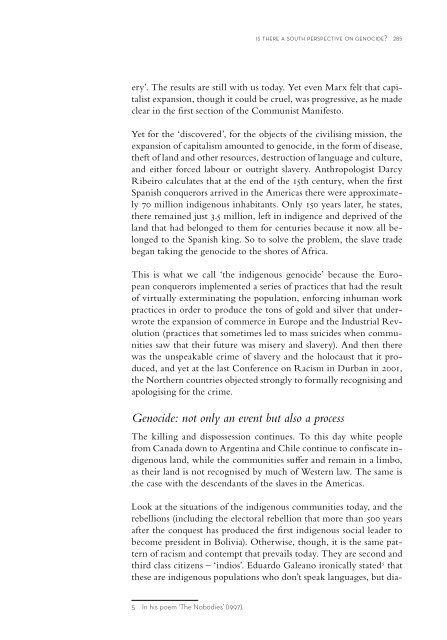60 years after the UN Convention - Dag Hammarskjöld Foundation
60 years after the UN Convention - Dag Hammarskjöld Foundation
60 years after the UN Convention - Dag Hammarskjöld Foundation
Create successful ePaper yourself
Turn your PDF publications into a flip-book with our unique Google optimized e-Paper software.
is <strong>the</strong>re a south perspective on genocide? 285<br />
ery’. The results are still with us today. Yet even Marx felt that capitalist<br />
expansion, though it could be cruel, was progressive, as he made<br />
clear in <strong>the</strong> fi rst section of <strong>the</strong> Communist Manifesto.<br />
Yet for <strong>the</strong> ‘discovered’, for <strong>the</strong> objects of <strong>the</strong> civilising mission, <strong>the</strong><br />
expansion of capitalism amounted to genocide, in <strong>the</strong> form of disease,<br />
<strong>the</strong>ft of land and o<strong>the</strong>r resources, destruction of language and culture,<br />
and ei<strong>the</strong>r forced labour or outright slavery. Anthropologist Darcy<br />
Ribeiro calculates that at <strong>the</strong> end of <strong>the</strong> 15th century, when <strong>the</strong> fi rst<br />
Spanish conquerors arrived in <strong>the</strong> Americas <strong>the</strong>re were approximately<br />
70 million indigenous inhabitants. Only 150 <strong>years</strong> later, he states,<br />
<strong>the</strong>re remained just 3.5 million, left in indigence and deprived of <strong>the</strong><br />
land that had belonged to <strong>the</strong>m for centuries because it now all belonged<br />
to <strong>the</strong> Spanish king. So to solve <strong>the</strong> problem, <strong>the</strong> slave trade<br />
began taking <strong>the</strong> genocide to <strong>the</strong> shores of Africa.<br />
This is what we call ‘<strong>the</strong> indigenous genocide’ because <strong>the</strong> European<br />
conquerors implemented a series of practices that had <strong>the</strong> result<br />
of virtually exterminating <strong>the</strong> population, enforcing inhuman work<br />
practices in order to produce <strong>the</strong> tons of gold and silver that underwrote<br />
<strong>the</strong> expansion of commerce in Europe and <strong>the</strong> Industrial Revolution<br />
(practices that sometimes led to mass suicides when communities<br />
saw that <strong>the</strong>ir future was misery and slavery). And <strong>the</strong>n <strong>the</strong>re<br />
was <strong>the</strong> unspeakable crime of slavery and <strong>the</strong> holocaust that it produced,<br />
and yet at <strong>the</strong> last Conference on Racism in Durban in 2001,<br />
<strong>the</strong> Nor<strong>the</strong>rn countries objected strongly to formally recognising and<br />
apologising for <strong>the</strong> crime.<br />
Genocide: not only an event but also a process<br />
The killing and dispossession continues. To this day white people<br />
from Canada down to Argentina and Chile continue to confi scate indigenous<br />
land, while <strong>the</strong> communities suff er and remain in a limbo,<br />
as <strong>the</strong>ir land is not recognised by much of Western law. The same is<br />
<strong>the</strong> case with <strong>the</strong> descendants of <strong>the</strong> slaves in <strong>the</strong> Americas.<br />
Look at <strong>the</strong> situations of <strong>the</strong> indigenous communities today, and <strong>the</strong><br />
rebellions (including <strong>the</strong> electoral rebellion that more than 500 <strong>years</strong><br />
<strong>after</strong> <strong>the</strong> conquest has produced <strong>the</strong> fi rst indigenous social leader to<br />
become president in Bolivia). O<strong>the</strong>rwise, though, it is <strong>the</strong> same pattern<br />
of racism and contempt that prevails today. They are second and<br />
third class citizens – ‘indios’. Eduardo Galeano ironically stated 5 that<br />
<strong>the</strong>se are indigenous populations who don’t speak languages, but dia-<br />
5 In his poem ‘The Nobodies’ (1997).

















